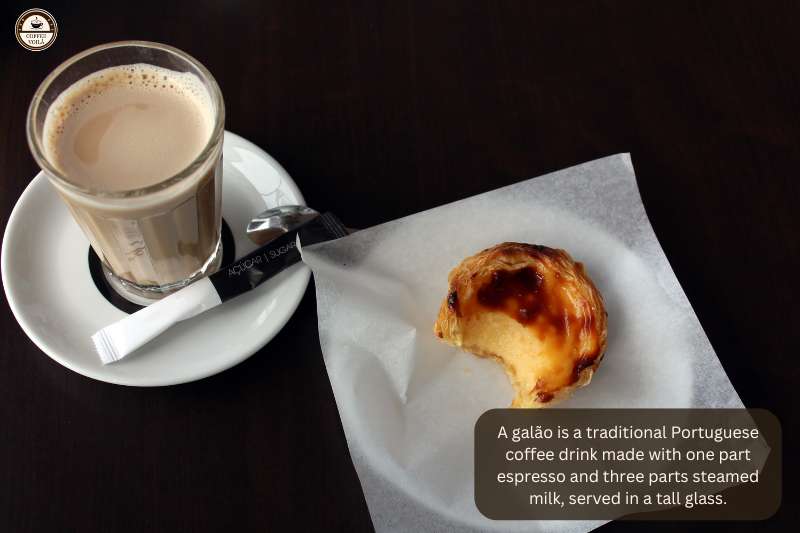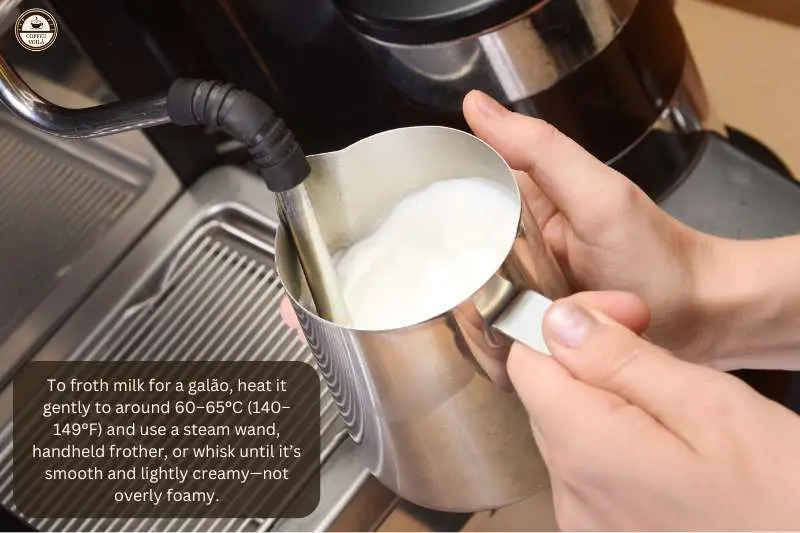How to Make a Galão (Authentic Portuguese Recipe)
Are you looking for something warm and creamy (kind of like a latte, but more Portuguese)?
One of my favorite Portuguese coffee drinks, hands down, is the galão. I’ve been a fan since I was a kid, usually enjoying it with thick buttery toasts or a tosta mista (which is basically a hot ham and cheese sandwich, toasted to golden perfection).
And I guess, after all these decades, I haven’t stopped loving that combo. It’s a breakfast classic around here, but honestly, I’ll take one any time of day.
In this guide, I’ll show you exactly how to make a galão at home, from the ingredients and tools you’ll need to the exact milk-to-coffee ratio that gives it that smooth, cozy feel.
You’ll also find barista tips, a few fun variations, and all the little details to get it just right. So let’s start brewing!
What Is a Galão?
A galão is one of Portugal’s most beloved coffee drinks and it’s the one I reach for almost every morning. It’s made with one part espresso and three parts steamed milk, served in a tall glass.
So, you can expect a smooth, warm drink, especially when paired with buttered toast (torradas com manteiga), which is a classic combo here.

Unlike the quick hit of a bica or café (similar to Portuguese espresso), a galão is meant to be sipped slowly. You’ll find it all over Portugal, from cafés in Lisbon to pastelarias in tiny villages.
| Drink | Ratio (Coffee:Milk) | Serving Style | Flavor & Texture |
|---|---|---|---|
| Galão | 1:3 | Tall glass | Light, creamy, smooth |
| Latte | 1:3 | Cup or glass | Creamy, often topped with microfoam |
| Café au Lait | 1:1 | Ceramic cup | Balanced, more robust than latte |
| Meia de Leite | 1:1 | Cup (not glass) | Richer than galão, less creamy than latte |
They’re all milk-based coffee drinks. But the proportions change everything. A galão is Portugal’s softer take.
When and How Locals Usually Drink It?
Most people in Portugal drink galão in the morning, often with toast, a croissant, or bolo de arroz (Portuguese rice muffin). It’s not something we rush with.
You’ll see folks at cafés, chatting or reading, slowly sipping away while the morning unfolds.
I’ve also seen it enjoyed mid-morning as a second breakfast. However, rarely after lunch or dinner (it’s not that kind of coffee). If you’re used to espresso all day, a galão might feel like a breakfast-only thing… and for most of us, it is.

Step-by-Step: How to Make a Galão at Home
Equipment
- Espresso machine, Moka pot, or AeroPress
- Milk steamer, frother, or even a small pot and whisk
- Tall glass, which is the traditional way to serve galão in cafés
Ingredients
- 1 shot of freshly brewed espresso (or strong coffee from a moka pot)
- Steamed milk, preferably whole milk for extra creaminess
- Optional: sugar or sweetener, depending on your taste
Instructions
- Brew Your Espresso or Strong Coffee: If you’re using an espresso machine, aim for about 25–30ml of dark and intense coffee. A moka pot works great too (make sure to use a dark roast). That extra boldness balances out the milk beautifully.
- Steam or Froth Your Milk: You want your milk hot but not boiling, around 60–65°C (140–149°F) is ideal. A steam wand gives the best texture, but if you’re using a handheld frother or heating it on the stove, just whisk until it’s velvety. It shouldn’t be super foamy like a cappuccino. The reason is galão milk is smooth but not bubbly.
- Combine and Serve: Now for the best part: pour your espresso into a tall glass, then gently add about three parts steamed milk. Go slow; it looks nicer and blends better. Also, you can add sugar if you like, but I find it perfect as is.
Video
Notes
Tip from locals:
Many Portuguese like to pour the milk first, then add the coffee on top for a layered look. It’s not a must, but it gives it that café touch you see here in Portugal.Barista Tips for the Perfect Galão
Making a galão is simple, but making a really good one? That takes a bit of know-how. So, here are a few barista-style tips I’ve picked up over the years to help you out:
1 – Choosing the Right Coffee Beans
Start with the right beans, and you’re halfway there. For a traditional galão, you want a dark roast. Something bold enough to hold up against all that milk.
I like using Delta Café or Nicola, both solid Portuguese brands you’ll find in most homes and cafés around here or on Amazon.

However, you can also try Lavazza Gran Espresso or Illy Classico if you’re shopping internationally. For this, look for blends with notes of chocolate or toasted nuts. Those flavors shine through in milk-based drinks like galão.
2 – Best Milk Frothing Techniques
You’re not going for cappuccino foam here. A galão should be creamy and smooth, with a light froth on top. I usually heat the milk to around 60–65°C (140–149°F) and use a steam wand or handheld frother until it’s silky.

If you’re using a stovetop, only heat the milk gently and whisk like crazy (I’ve done that in a pinch, and it works). Just don’t boil the milk. Burnt milk = ruined galão.
3 – How to Prevent Bitterness or Weak Flavor
Bitterness commonly means your coffee is over-extracted. If you’re using a moka pot, try removing it from the heat as soon as the coffee starts gurgling.
For espresso machines, you want between 25–30 seconds of extraction and clean your portafilter regularly (old grounds add bitterness).

On the flip side, a weak galão probably means your coffee-to-milk ratio is off. You should stick with 1 part espresso to 3 parts milk, and if it still tastes too light, ask yourself, “was the coffee strong enough to begin with?” If not, it’s time to switch your beans or grind finer.
Other Galão Variations You Can Try
While the classic galão is amazing, you can still try a few fun variations that suit different seasons, diets, or preferences. So, here’s some suggestions:
Iced Galão (Summer Twist)
When it’s hot outside, I don’t always feel like sipping on something warm. That’s when I go for an iced galão. Same 1:3 ratio of espresso to milk, but poured over ice.

Some cafés will make it for you if you ask for “galão com gelo,” though it’s not always on the menu. At home, I brew my coffee in advance, let it cool, then shake it with ice and milk in a jar.
Pro tip: sweeten it while the coffee is still hot. Because sugar doesn’t dissolve well in cold drinks.
Plant-Based Versions (Oat, Almond, or Soy Milk)
If you’re dairy-free or exploring alternatives, galão works surprisingly well with plant-based milks. For instance:
Oat milk is my favorite: it froths up nicely and has a subtle sweetness that pairs beautifully with espresso. Almond milk gives it a nutty edge, and soy’s a solid all-rounder.

Just make sure to warm the milk gently and avoid boiling. Some non-dairy milks separate when overheated, and no one wants a curdled galão.
Galão Escuro vs Galão Claro (Stronger vs Lighter)
This one’s more subtle, but makes a real difference in flavor. For example, Galão escuro is made with more coffee and less milk, so it’s bolder (closer to a meia de leite).
Meanwhile, Galão claro is milkier, softer, and usually lighter in flavor.
Some coffee shops list them right on the menu, but most don’t. If you’re picky (like I am), it’s worth asking for “um galão escuro” or “um galão claro” to get it just how you like. At home, it’s even easier; you adjust the ratio to your taste.
Last Thoughts
So, have you tried making a galão yet? I’d love to know how you prefer it: darker and stronger with less milk, or on the lighter, creamier side?
What coffee brand are you using at home? And if you’ve discovered any unique tricks or variations along the way, definitely share them in the comments.
Questions? We Have Answers.
Get answers to a list of the most Frequently Asked Questions.







